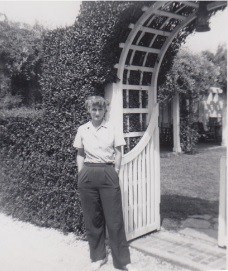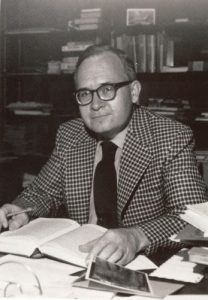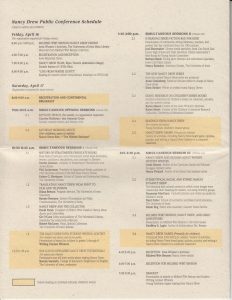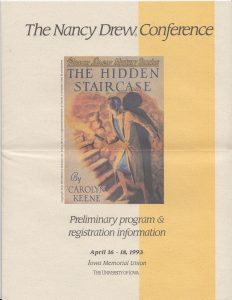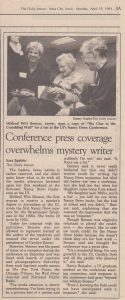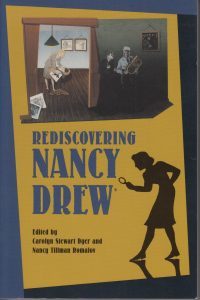An Initial Inquiry
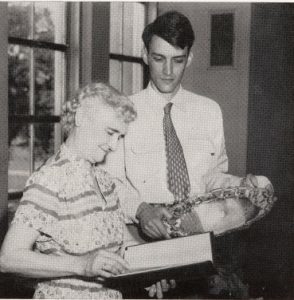
Grace Van Wormer receives recognition for her work of 42 years at the University of Iowa Main Library, 1954
In 1953, a correspondence started between Mildred Wirt Benson and Grace Van Wormer, the assistant director of the library at the State University of Iowa (now known as the University of Iowa). The exchange began in February, when Wormer wrote to Benson with a request for a complete list of her written works. The library was in the process of building a collection of books written by Iowa authors and wanted to include Benson’s writings. Her name had been recommended to them by Graham Dean, another Iowa author. Library staff members, however, were struggling to find a conclusive list of her work. Wormer noted, “We find that some of them are given in the Library of Congress Catalog, but we fear that is it not a complete list.”
Benson did her best to honor the contracts she had signed with the Stratemeyer Syndicate over the years. In a 1964 letter to Frank Paluka, the head of the Special Collections Department at the University of Iowa Libraries, she noted that the background history she shared about her contract with the Syndicate was “for informational purposes only, not to be used as a published statement.” She clearly listed which pseudonyms were Syndicate-owned and denied any connection to the revised editions.
Continuing Correspondence
Mildred Wirt Benson and Frank Paluka maintained contact throughout the years. Paluka wanted to add to Benson’s growing collection of papers at the Special Collections Department and would periodically request manuscripts from her. She confessed she got rid of many of her early drafts, but sent the items that were left. She agreed to write a piece titled “The Ghost of Ladora” to discuss her writing history and sources of inspiration. She also looked over his efforts to collect all of her books for the Special Collections Archives, at one point noting, “You have, I believe, the only complete listing of my books in the country, as even the Library of Congress does not have it, as the Syndicate closed off any such listing years ago.”
In the 1960’s Harriet Stratemeyer Adams, senior partner at the Syndicate and daughter of founder Edward Stratemeyer, began publicly declaring herself as the true author of the Nancy Drew Mystery Stories. The resulting interviews and news stories about her life and work with the Syndicate flooded the nation. Benson didn’t openly challenge the claim, but she was paying attention. In 1973, Paluka asked if Benson would consider donating her copies of the original Nancy Drew novels to the Special Collections Department. Benson responded, “I especially wanted to write about Nancy Drew, for Mrs. Adams of the Syndicate is blanketing the country with statements that she is the author. It seems silly, yet I do hate to see facts distorted.” Four years later in 1977, she wrote, “…you must have read that Mrs. Adams claims to have written ALL of the books and she no longer admits to any having been ghost written. On other series, she states that “half ghosts” sometimes were used – whatever a half ghost is!”
The staff at the University of Iowa Libraries was also watching the media circus surrounding Adams. “I thought you might be interested in this AP story,” staff member Susan Aukema wrote to Paluka in March 1980. “I don’t see how Adams can get away with these blatant lies. What can be done? Have you heard from OUR Carolyn Keene lately?” Paluka would soon. About a week later, he received word from Benson that litigation between publishing companies Grosset & Dunlap and Gulf & Western Corporation, the parent company of Simon & Schuster, was underway.
The Only Ghost Alive
The plaintiff of the case was Grosset & Dunlap. The publishing company brought both the Gulf & Western Corporation and the Stratemeyer Syndicate to court for what they claimed was a breach of contract. The Syndicate had recently entered into a new contract with Simon & Schuster, granting the company the rights to all future titles and the ability to publish paperback novels. Grosset & Dunlap, which had been publishing hardcovers for the Syndicate since 1930, argued that the Syndicate had no right to change publishing companies because they didn’t truly own the work. The books had been written by ghost writers, not the Syndicate. As proof, Grosset & Dunlap asked Benson to the witness stand. By that time, Benson was the “only remaining ghost still alive” and eager to take the stand. For years, Adams had distorted the truth around the Nancy Drew Mystery series. As a journalist who believed in honesty and integrity, Benson wanted to set the record straight.
Grosset & Dunlap lost the court case, but Benson succeeded in meeting her objective. As a witness in the case, she was able to talk about her involvement with the creation of Nancy Drew and officially correct misunderstandings and falsehoods. “I was on the stand for two days so my entire story is on the record with respect to the Nancy Drew series,” she informed Paluka in December 1980. “Mrs. Adams acknowledged my part in the series and refuted nothing.”
In 1982, Benson had further cause to celebrate: thanks to the perseverance of Geoffrey Lapin, the Library of Congress decided to credit Benson with all of the books she had ever written, including those belonging to the Stratemeyer Syndicate. Grace Van Wormer’s earlier suspicion that the Library of Congress Catalog was not complete in regards to Benson’s work was now resolved, and in part because of the list of books she had requested from Benson back in 1953. Paluka had used that document to create an updated and more thorough listing and Lapin, in turn, used that compilation to prove Benson’s authorship of Syndicate books to the Library of Congress staff. That same list was used in the trial that confirmed Benson as the first ghost writer of the Nancy Drew Mystery Stories. The record of Benson’s work was finally complete and public. “This,” Benson gratefully wrote to Paluka, “should mark the end of my Nancy Drew tribulations.”
Perhaps so, but the Nancy Drew celebrations were just on the horizon.
A Discovery
In the summer of 1991, eleven years after the trial, Susan Redfern was working as an undergraduate secretary in the School of Journalism & Mass Communication. As one of her summer projects, Redfern began cleaning out alumni files. She started at the beginning of the alphabet with the letter A and made her way through the folders, tossing out duplicates and organizing the remaining pages. Soon, the file of Augustine, Mildred, M.A. 1927 reached her desk.
The documents in the file told an impressive story. Mildred Augustine was not only the first person to graduate with a master’s degree from the School of Journalism & Mass Communication, but she also became a prolific author of children’s books. Tucked into the file was an alumni article from 1985 discussing her work with the Stratemeyer Syndicate and the beginning of the Nancy Drew Mystery Series. According to these papers, Mildred Augustine Wirt Benson was the original Carolyn Keene.
Redfern shared her discovery with the staff and faculty, including assistant professor Sue Lafky. The lack of recognition given to Benson astonished the women. Her books were well known and loved by many readers. Why wasn’t her alma mater celebrating her life work and achievements? Lakfy was determined to rectify this slight by nominating Benson for the journalism school’s alumni Hall of Fame. She and the office staff launched a campaign that eventually moved beyond the School of Journalism & Mass Communication and into other departments. Benson supporters from all over campus were encouraging journalism faculty members to vote her into the Hall of Fame. At this point, as Carolyn Stewart Dyer later wrote, “The Hall of Fame nomination ballot hadn’t even been circulated.”
Mildred Benson was voted into the Hall of Fame later that year. After the news of her up-coming induction spread through word of mouth, the women faculty at the School of Journalism began fielding numerous phone calls from fans of Nancy Drew. The more calls they received from these excited readers, the more faculty realized the significance of Nancy Drew and the woman who first wrote about her. Dyer reflected later, “…there seemed to be a story in this Nancy Drew phenomenon, and we began to dig into it.”
They quickly discovered there was a lot of material surrounding Nancy Drew. Fascination with the teenage sleuth had generated fan clubs and news articles across the country. While there was some scholarship, they realized there was very little academic research on any popular culture subject pertaining to girls’ interests and activities. These findings inspired the Nancy Drew Project, which culminated in the weekend-long Nancy Drew Conference in April 1993.
As Big as the Rose Bowl
The Nancy Drew Conference, hosted by the University of Iowa, was intended to explore, analyze, and celebrate the popular teenage detective in a way that appealed to a broad spectrum of people. The fans of the series ranged from students in grade school to tenured professors and from first time readers to avid collectors. There was a press conference with Mildred Wirt Benson, a session with a current Nancy Drew ghost writer, showings of Nancy Drew films, readings, and games. In addition, there were scholarly sessions that covered topics such as the history of the series and the gender roles of the characters. Nancy Tillman Romalov, a University of Iowa graduate student who worked on the conference steering committee, stated, “It’s so inclusive. People are coming from every possible interest area. We’ve also made efforts to involve children, and that’s quite unusual for a conference.”
This conference was a part of the much larger Nancy Drew Project, which also included a state-wide essay contest for children, solve-a-mystery dinners for teenagers, and reading groups for adults. The Project was supported by the Iowa Humanities Board, the National Endowment for the Humanities, the Iowa Newspaper Association, several departments at the University of Iowa, the public libraries of Iowa City, Coralville, and Cedar Rapids, and several generous citizens and businesses.
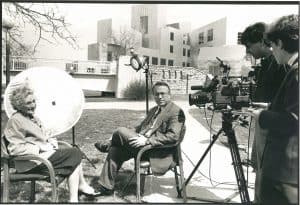
Mildred Wirt Benson interview with CBS-News reporter Richard Threlkeld, April 17, 1993. Image taken by John Kimmich.
Dyer, the coordinator and chair of the Nancy Drew Conference, wrote that the event had several purposes. One was to explore the character of Nancy Drew and her place in popular culture by studying the history of the series. Organizers also hoped to tackle the controversies surrounding the series and to observe the various impacts these books had on readers. Finally, there was a desire to recognize Mildred Wirt Benson as the original writer and make known her contributions to the character of Nancy Drew.
The Nancy Drew Conference was attended by about 500 people. These Nancy Drew enthusiasts were of all ages and came from all walks of life, including children, teachers, librarians, journalists, collectors, scholars, and most of all, readers.
The Conference was well-covered in national and international media, finding its way into several major newspaper headlines, as well as magazines, radio broadcasts, and television news stories. Dyer noted the Conference received “probably more coverage than any other University of Iowa event except the participation of its football teams in the Rose Bowl.”
The Conference made great strides in reviving American and worldwide interest in Nancy Drew, but it was the guest of honor, Mildred Wirt Benson, who found herself in the spotlight. The great recognition finally given to her meant that her anonymity as the original Carolyn Keene was lost. On the first night of the Conference, Benson was named the Person of the Week by Peter Jennings on ABC-TV News. Within a year and a half, she was inducted into both the Ohio Women’s Hall of Fame and the Iowa Women’s Hall of Fame. She was also honored with the University of Iowa’s Distinguished Alumni Award. Many other awards were to follow, along with interviews, fan mail, and numerous phone calls.
Although the Conference took place in 1993, the scholarly work and discussions prompted from the event persist. Dyer and Romalov co-edited a book titled Rediscovering Nancy Drew that contains reader testimonials and interviews. Other submissions from the Nancy Drew Conference can be found in the Carolyn Dyer papers in the Iowa Women’s Archives.
A Note on Sources
Mildred Augustine Wirt Benson papers, Iowa Women’s Archives, University of Iowa Libraries
Administrative Files, Special Collections & University Archives, University of Iowa Libraries
Carolyn Stewart Dyer papers, Iowa Women’s Archives, University of Iowa Libraries
Nancy Drew Collection papers, Iowa Women’s Archives, University of Iowa Libraries
Carolyn Stewart Dyer and Nancy Tillman Romalov, Rediscovering Nancy Drew (University of Iowa Press, 1995)
Melanie Rehak, Girl Sleuth: Nancy Drew and the Women Who Created Her (Harcourt, Inc., 2005)
Julie K. Rubini, Missing Millie Benson: The Secret Case of the Nancy Drew Ghostwriter and Journalist (Ohio University Press, 2015)
Quotations
“We find that some”: Letter from Wormer to Benson, February 17, 1953. Correspondence, 1964-1986. Bibliographic Material. Mildred Augustine Wirt Benson papers, Iowa Women’s Archives, University of Iowa Libraries.
“As for a list”: Letter from Benson to Wormer, February 25, 1953. Correspondence, 1964-1986. Bibliographic Material. Mildred Augustine Wirt Benson papers, Iowa Women’s Archives, University of Iowa Libraries.
“One such author”: Letter from Benson to Wormer, April 23, 1953. Correspondence, 1964-1986. Bibliographic Material. Mildred Augustine Wirt Benson papers, Iowa Women’s Archives, University of Iowa Libraries.
“For informational purposes”: Letter from Benson to Paluka, July 5, 1964. Correspondence, 1964-1986. Bibliographic Material. Mildred Augustine Wirt Benson papers, Iowa Women’s Archives, University of Iowa Libraries.
“You have, I believe”: Letter from Benson to Paluka, October 19, 1977. Correspondence, 1973-2007. Benson, Mildred Augustine Wirt. Iowa Authors. Administrative Files, University of Iowa Libraries.
“I especially wanted”: Letter from Benson to Paluka, 1973. Correspondence, 1964-1986. Bibliographic Material. Mildred Augustine Wirt Benson papers, Iowa Women’s Archives, University of Iowa Libraries.
“you must have read”: Letter from Benson to Paluka, October 19, 1977. Correspondence, 1973-2007. Benson, Mildred Augustine Wirt. Iowa Authors. Administrative Files, University of Iowa Libraries.
“I thought you might be interested”: Memo from Aukema to Paluka, March 4, 1980. Awards. Biographical Material. Mildred Augustine Wirt Benson papers, Iowa Women’s Archives, University of Iowa Libraries.
“Only remaining ghost”: Letter from Benson to Paluka, March 11, 1980. Correspondence, 1964-1986. Bibliographic Material. Mildred Augustine Wirt Benson papers, Iowa Women’s Archives, University of Iowa Libraries.
“I was on the stand”: Letter from Benson to Paluka, December 28, 1980. Correspondence, 1964-1986. Bibliographic Material. Mildred Augustine Wirt Benson papers, Iowa Women’s Archives, University of Iowa Libraries.
“This should mark”: Letter from Benson to Paluka, December 14, 1982. Correspondence, 1964-1986. Bibliographic Material. Mildred Augustine Wirt Benson papers, Iowa Women’s Archives, University of Iowa Libraries.
“The Hall of Fame”: Carolyn Stewart Dyer, “The Nancy Drew Phenomenon.” Rediscovering Nancy Drew (University of Iowa Press, 1995): 3
“there seemed to be”: Carolyn Stewart Dyer, “The Nancy Drew Phenomenon.” Rediscovering Nancy Drew (University of Iowa Press, 1995): 3
“It’s so inclusive”: Sara Epstein, “Nancy Drew fans flock to UI for 1st historical conference.” Daily Iowan. April 16, 1993. Newspaper clippings. Conference files. Nancy Drew Collection, Iowa Women’s Archives, University of Iowa Libraries.
“probably more coverage”: Carolyn Stewart Dyer, “The Nancy Drew Phenomenon.” Rediscovering Nancy Drew (University of Iowa Press, 1995): 5
Images
Grace Van Wormer: Faculty & Staff Vertical Files Collection, Special Collections & University Archives, University of Iowa Libraries
Frank Paluka: Faculty & Staff Vertical Files Collection, Special Collections & University Archives, University of Iowa Libraries

